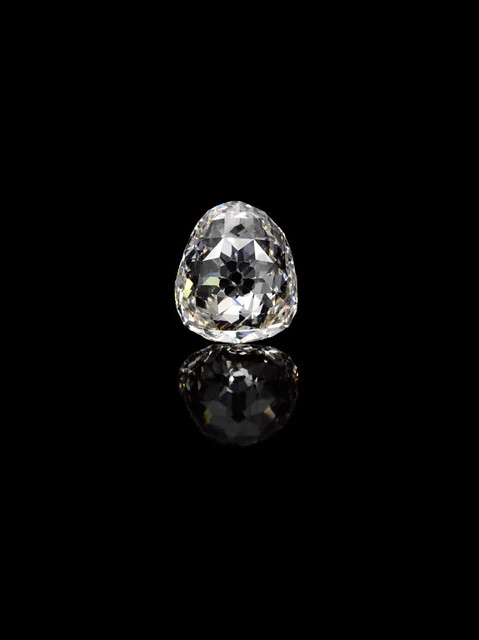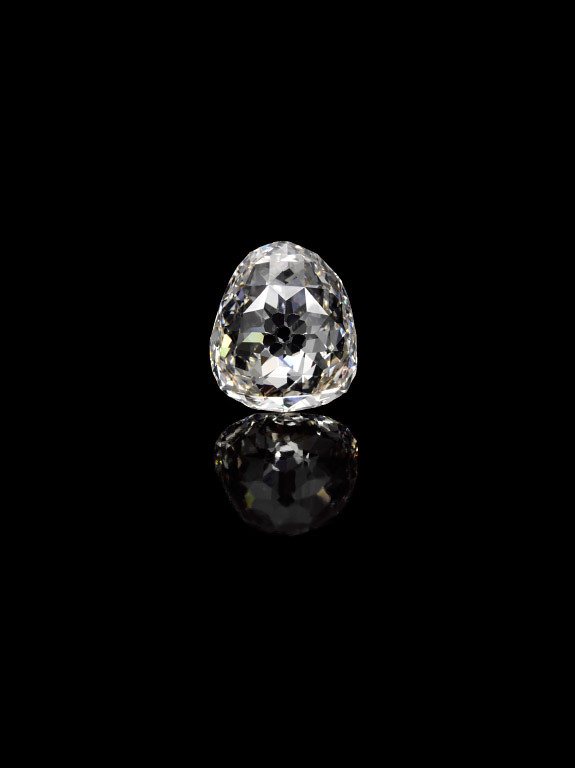
The historically important 34.98 carat Beau Sancy, estimated at between RM 6 million to RM 12 million---a steal but I predict when Sotheby's auctions it on 15 May in Geneva, it might fetch RM 120 million!
THIS IS THE DIAMOND I HAVE ALWAYS DREAMED OF OWNING! THE BEAU SANCY WEIGHS 34.98 CARATS AND WILL BE AUCTIONED BY SOTHEBY'S ON 15 MAY 2012 IN GENEVA, SWITZERLAND. SUCH MAGNIFICENT GEMS TEND TO BE AUCTIONED IN SWITZERLAND WHERE THE ILL-GOTTEN GAINS OR LEGIT BILLIONS ARE STASHED. NOT FOR NOTHING IS THE TERM 'BANKING GNOMES' USED TO DESCRIBE THE SWIZZ FINANCIERS, A TERM WHICH THEY HATE AS IT EVOKES IMAGES OF THE SLEAZY BANKERS IN THE HARRY POTTER MOVIES!
Of course Geneva and all of Switzerland is generally awashed with cold, liquid cash so RM 6 million to RM 12 million should be loose change. However for such a massive diamond of 34.98 carats, the asking price is far too low as even I can afford to pay RM 12 million at its upper estimate let alone a mere RM 6 million at its lowest estimate!
I predict it will go for RM 80 to RM 120 million! A good 8-carat diamond already costs RM 12 million and this monster weighs nearly 35 carats! And the Beau Sancy has a track record any diamond would give up its eternity to have---a 400 year provenance that can be traced back to the 16th century! That diamond on your finger has no history, glamour or importance attached to it if it was extracted from the earth a dozen years ago or worse, 3 years ago.
So it is time to upgrade to a bigger rock!
The 34.98 carat Beau Sancy is not to be confused with its bigger cousin simply called the Sancy or Grand Sancy which weighs 55.23 carats and is safely in the Louvre museum in Paris! So think for a moment that the embattled President Sarkozy of an ex-AAA France has fallen on such hard times the national museum is resorting to selling its treasures and Mona Lisa will be on sale anytime soon.
The Sancy and Beau Sancy are so famous their names are intertwined and many assume they are one and the same. They are 2 different ones and the bigger one was sold to King James I of England to the chagrin of Queen Marie de Medici of France. The French queen regarded the Beau Sancy so highly she placed it atop her crown during her coronation as seen in the magnificent portrait by Frans Pourbus the Younger painted in 1610.
A diamond of supreme historical importance
THE BEAU SANCY
-- Passed down through four royal families,
Worn by Marie de Medici in her crown at her coronation
as Queen Consort of Henri IV in 1610,
this celebrated gem is testament to over
400 years of European history –
The Beau Sancy, A modified pear double rose cut diamond
weighing 34.98 carats (est. $2-4 million)
SOTHEBY’S GENEVA is delighted to announce its sale of Magnificent Jewels
and Noble Jewels on 15 May 2012 will be led by the Beau Sancy, one of the most important historic diamonds ever to come to auction. Passed down through the Royal Families of France, England, Prussia and the House of Orange, the celebrated diamond has been the privileged witness of 400 years of European history. Weighing 34.98 carats, the modified pear double rose cut diamond comes to the market with an estimate of $2-4 million*.
Commenting on the forthcoming sale of the Beau Sancy, David Bennett, Chairman of Sotheby’s
Jewellery Department in Europe and the Middle East and Co-Chairman of Sotheby’s Switzerland
said: “The Beau Sancy is one of the most fascinating and romantic gems ever to appear at auction and it is an immense privilege for Sotheby’s to handle the sale”.
Acquired by Nicolas de Harlay, Lord of Sancy (1546-1629), in Constantinople in the mid to
late 1500’s, the Beau Sancy is most likely to have originated from the mines in southcentral
India near the city of Golconda, the source of history’s best-known diamonds,
including the Hope, the Koh-i-Noor and the
Regent. In 1604, the Beau Sancy was bought
for 75 000 livres (25 000 écus) by Henri IV
and gifted to his wife, Marie de Medici. The
Queen of France had long desired the stone,
particularly after learning that de Sancy had
sold a larger stone, today known as the
“Sancy”, to King James I of England1.
Testament to the importance her Majesty
placed on the diamond, the Beau Sancy was
mounted atop the crown she wore at her
coronation in 1610, as shown in a magnificent
portrait by Frans II Pourbus, the Younger, now
in the Louvre.
Following Henri IV’s assassination by Ravaillac, the Queen was
exiled in disgrace and escaped to the Netherlands. Heavily in debt,
her possessions were sold and the Beau Sancy was acquired by
Prince Frederick Hendrick of Orange-Nassau (1584-1647) for 80
000 florins - the most important expenditure in the state’s budget
in 1641. In the same year, in an attempt to reinforce the alliances of
the United Provinces of Holland with the great European powers,
the diamond was used to seal the arrangement of the wedding of
Frederick Hendrick’s son, Willem, later Willem II of Orange Nassau (1631-1660), to Mary Stuart, daughter of Charles I of England and Henriette-Marie of France, and grand-daughter of Marie de Medici.
After the death of her husband, Mary Stuart embarked for England with her jewels in order to support her brother Charles II in his fight for the throne. In 1662, the Beau Sancy was pawned to settle her debts and it was only in 1677, on the occasion of the wedding of Willem III of Orange-Nassau (1650-1702) to Mary II Stuart, daughter of the King of England James II, that the diamond reentered the Treasure of the House of Orange-Nassau. In 1689, the couple ascended the throne of England and thus the Beau Sancy now joined the collection of the Queen of England. However, as the monarchs were childless at their death, the diamond went back to the House of Orange-Nassau.
In 1702, following the settlement of a dispute between the heirs to the House of Orange, Friedrich I who had just been crowned the first King of Prussia, gave up the jewels of his legacy to obtain the Beau Sancy. The symbolic value and the prestige of the celebrated gem were such that the King made it the principal ornament of the new royal crown of Prussia and associated it with the first order of Prussia, the Order of the Black Eagle.
The largest gemstone within the House of Prussia’s collection, the Beau Sancy passed down to each successive generation until today. Worn by the women of the family on important royal occasions, the diamond adorned the costume of each successive bride on the day of her princely wedding, much like it had in the past. When the last German Emperor and King of Prussia fled to exile in Holland, in November 1918, the crown jewels remained at the Kaiser’s palace in Berlin. At the end of World War II, the collection was transferred to a bricked-up crypt for safe keeping in Bückeburg, where it was later found by British troops and returned to the estate of the House of Prussia.
After the war, the diamond was subsequently passed down to the eldest son of the Kaiser, Kronprinz Wilhelm (1882-1951) and his son, Prince Louis Ferdinand (1907-1994). After the death of Prince Louis Ferdinand, the diamond was inherited as part of the estate by his grandson, Georg Friedrich (1976-), Prince of Prussia and current head of the Royal House of Prussia.
The Beau Sancy has been shown publicly only four times in the last 50 years: first in 1972, alongside the Grand Sancy in Helsinki, in 1985, in Hamburg at the Schmuck aus dem Hause Hohenzollern exhibition, in 2001, in Paris again alongside the Grand Sancy at the Musée National d’Histoire Naturelle, and finally in 2004, in Munich at the Schatzhäuser Deutschands exhibition.
One last look;

The Beau Sancy will be showcased in an international tour before its auction in Geneva on 15 May 2012.
Public exhibition:
Hong Kong 30 March - 2 April 2012
New York 14-16 April 2012
Rome 19 April 2012
Paris 24-25 April 2012
London 27-30 April 2012
Zurich 2-3 May 2012
Geneva 11-15 May 2012
* Pre-sale estimates do not include buyer’s premium




No comments:
Post a Comment